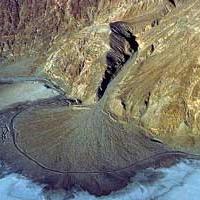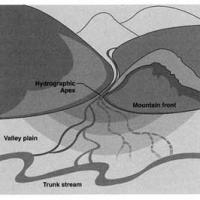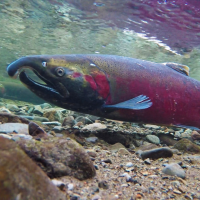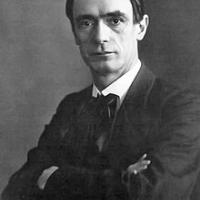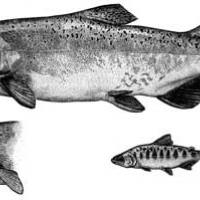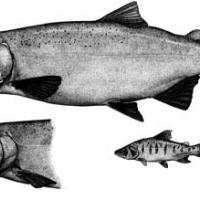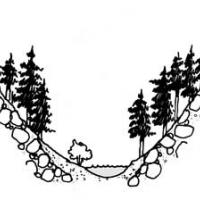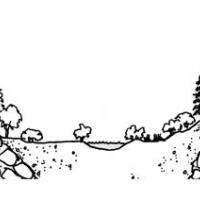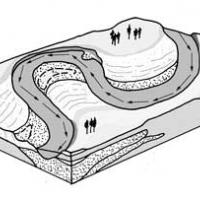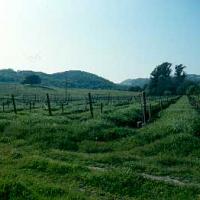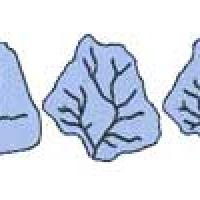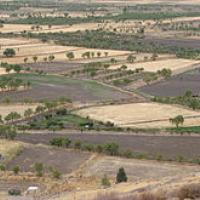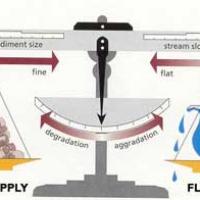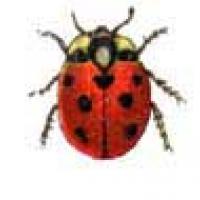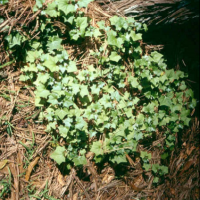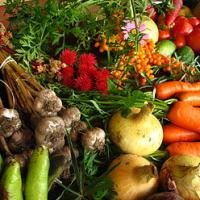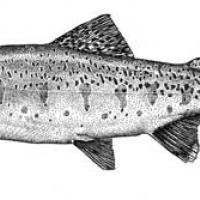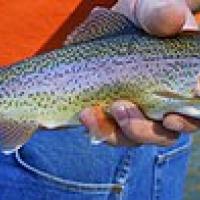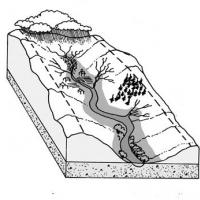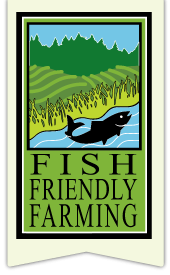Definitions
Here is a helpful list of terms with definitions used throughout our website.

Here is a helpful list of terms with definitions used throughout our website.
Terms and definitions related to area watersheds. Click the graphics below to view and read about each.
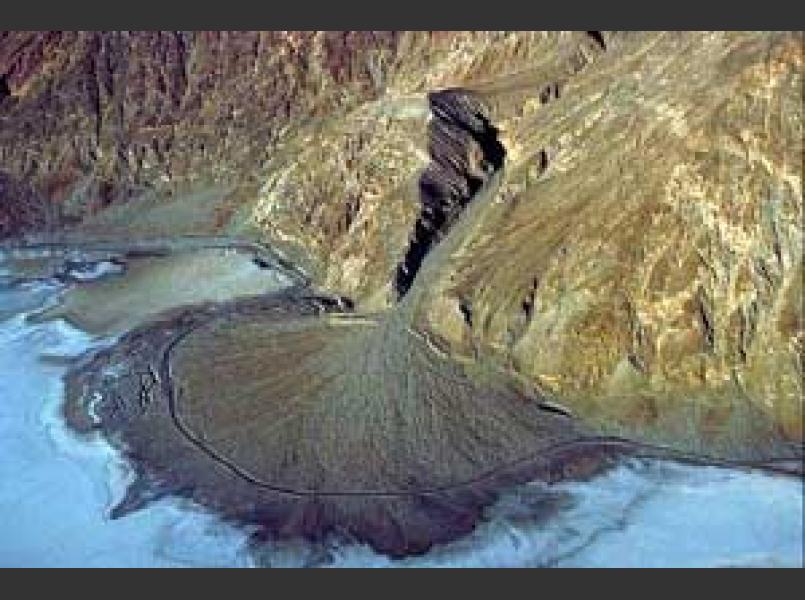 Alluvial Fan Photo
Alluvial Fan PhotoAlluvial fans are cone-shaped deposits of boulders, cobble, gravel, and sand. They form where a fast-flowing stream exits a canyon and slows and spreads out onto a flatter plain. Alluvial fans typically have multiple stream channels. These channels shift location as material accumulates in one location and is scoured in another. Alluvial fans are different in form and function from streams on the valley floor, and restoration projects in alluvial fan channels often fail due to a lack of understanding of the hydraulics of these streams.
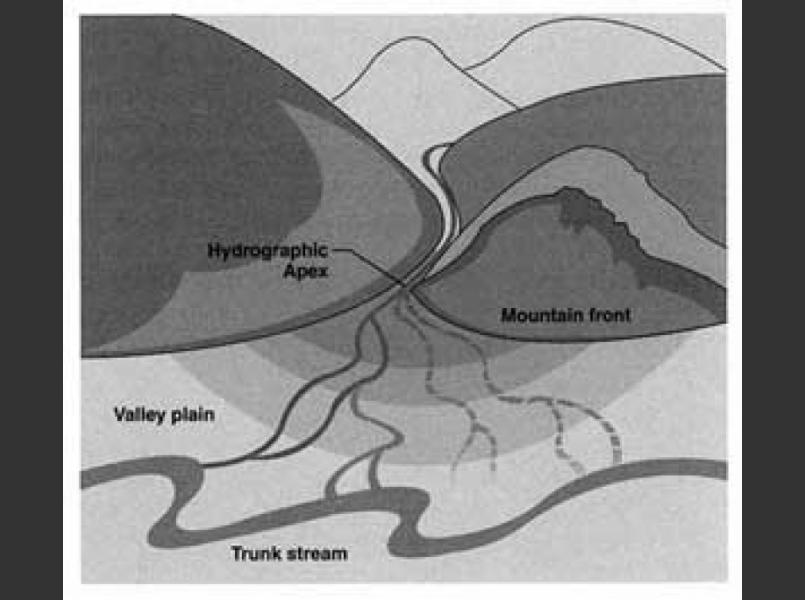 Alluvial Fan Chart
Alluvial Fan ChartAlluvial fans are cone-shaped deposits of boulders, cobble, gravel, and sand. They form where a fast-flowing stream exits a canyon and slows and spreads out onto a flatter plain. Alluvial fans typically have multiple stream channels. These channels shift location as material accumulates in one location and is scoured in another. Alluvial fans are different in form and function from streams on the valley floor, and restoration projects in alluvial fan channels often fail due to a lack of understanding of the hydraulics of these streams.
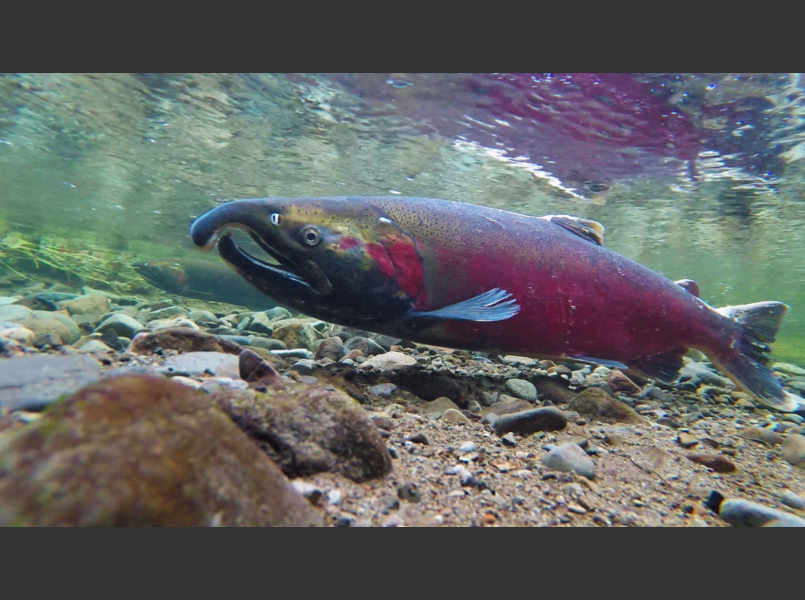 Anadromous
AnadromousAnadromous fish are born in fresh water and migrate to salt water where they grow to be large adults (see Salmon Lifecycle). Adult fish return to the same fresh water breeding grounds to spawn. Chinook salmon, Coho salmon, and steelhead trout are examples of anadromous fish.
 Biodynamic farming
Biodynamic farming Biodynamic farming – Biodynamic farming was developed by Dr. Rudolf Steiner in the 1920s, in response to concerns about deteriorating soil conditions. The philosophy of biodynamic farming is founded on the concept of the farm as an integrated, living organism. Maintenance of the soil and recycling of nutrients are emphasized.
 Channel entrenchment or incision
Channel entrenchment or incisionChannel entrenchment or incision – Stream channels are changed by flood event and reflect disturbance and land uses in their watersheds as well as their geology and climate. In California, many streams are incised or entrenched into their floodplain. A stream in this condition is narrow and deep or trench-like as opposed to a wide and shallow channel or multi-channeled system.
Channel entrenchment often occurs as a result of major disturbances in the watershed, including reservoirs, urbanization, gravel mining, or channelization and floodplain development. The channel adjusts to a large increase in runoff due to urbanization, for example, or adjusts to a large decrease in sediment supply such as occurs with large on-stream dams and reservoirs. The stream adjusts to the change in runoff volume or sediment supply by eroding its bed and banks and incising into its floodplain. As the channel erodes into the floodplain, flood flows become confined to the entrenched channel and move at high velocity rather than slowing and spreading out over the floodplain. All of the erosive energy of the floodwater is focused on the bed and banks of the channel and the channel continues to deepen. The high velocity flood flows in entrenched channels often scour out gravel bars and riffles (habitat for salmon and trout) as well as riparian trees. Over time the channel will deepen so much that the steep vertical banks will fail and slump, widening the channel and forming a new floodplain. There is now a wider but lower channel and flood flows spread out over the new floodplain and slow down, resulting in less erosion of the bed and banks of the channel.
Aquatic and riparian habitats are not supported in the early stages of the entrenchment process and are often scoured out. Restoration projects need to address the high velocity flow by widening the channel; otherwise, habitats will continue to be scoured out. Once widened, the channel will be better able to form and sustain riffles, pools, instream habitats and riparian forest.
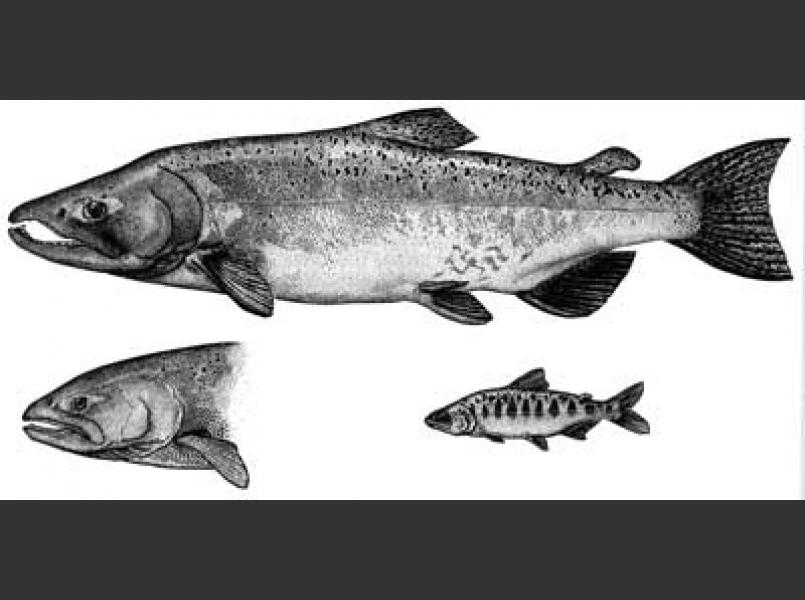 Chinook salmon (Oncorhynchus tshawytscha)
Chinook salmon (Oncorhynchus tshawytscha)Chinook salmon (Oncorhynchus tshawytscha) – Chinook or king salmon is an anadromous fish that ranges from Kotzebue Sound, Alaska to Santa Barbara, California. Chinook fry leave the river several months after emergence from the spawning redd. They typically spend several years as adults in the ocean before returning to their natal stream to spawn. Chinook spawn in large streams and rivers such as the Russian, Napa, and Sacramento Rivers. Chinook salmon are the largest Pacific salmon and average 30-40 inches in length.
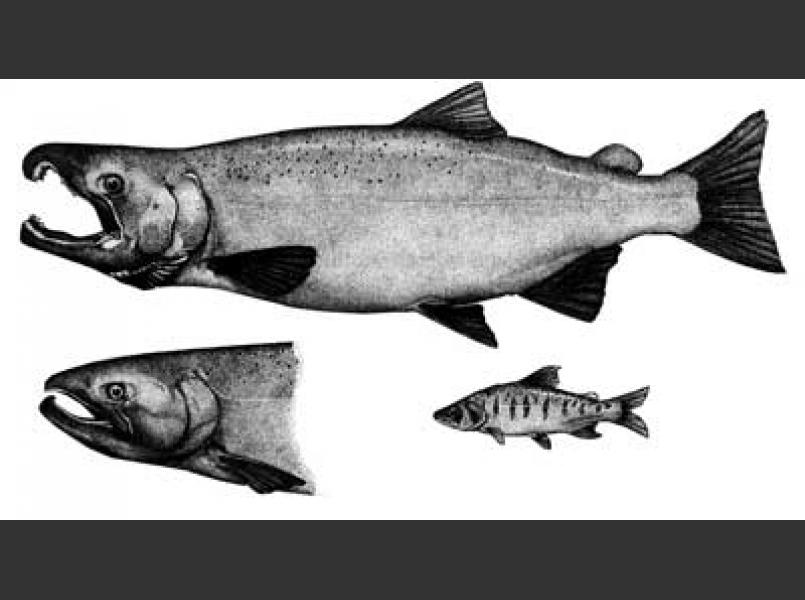 Coho salmon (Oncorhynchus kisutch)
Coho salmon (Oncorhynchus kisutch)Coho salmon (Oncorhynchus kisutch) – Coho salmon are an anadromous fish that range in the U.S. from Point Hope, Alaska to Monterey Bay, California. They average 24-28 inches in length and are typically found in coastal streams and the tributaries of larger rivers. Young coho salmon (“fry”) remain in their natal streams for approximately 1-4 years before migrating out to sea to spend their adult lives in the ocean. Central California Coast Coho salmon were federally listed as an endangered species in 2005.
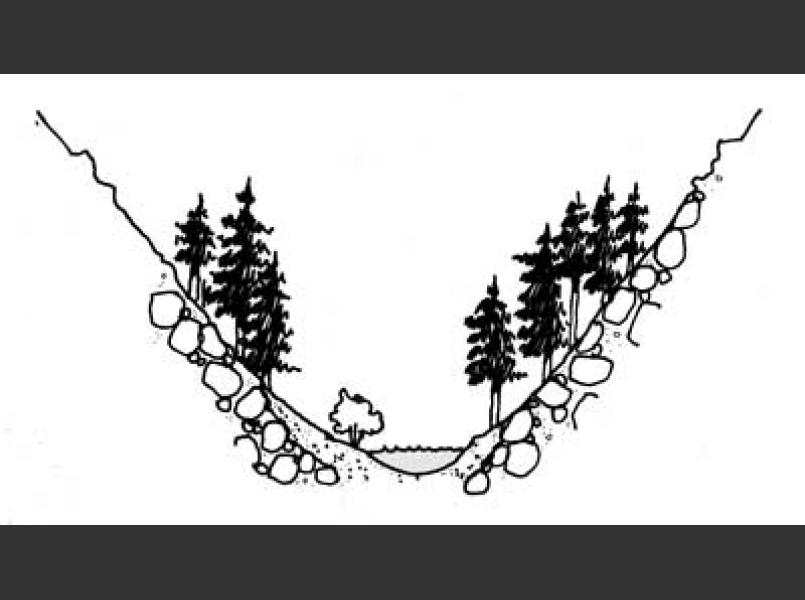 Confined/unconfined channel
Confined/unconfined channel Confined/unconfined channel – The Fish Friendly Farming Environmental Certification Program separates creek channels into two types according to their geologic features: confined and unconfined. Confined channels are in rocky canyons and gorges and are largely non-meandering and usually steep in slope. Unconfined channels are meandering channels typical of valley floors and are usually low in slope. Floods can scour and deposit sediment along the channel, changing its location and form.
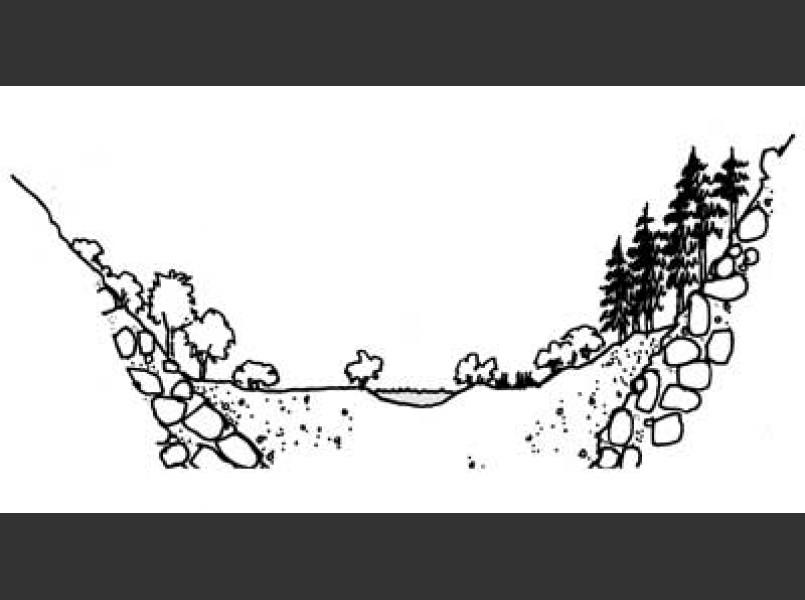 Unconfined channel
Unconfined channelConfined/unconfined channel – The Fish Friendly Farming Environmental Certification Program separates creek channels into two types according to their geologic features: confined and unconfined. Confined channels are in rocky canyons and gorges and are largely non-meandering and usually steep in slope. Unconfined channels are meandering channels typical of valley floors and are usually low in slope. Floods can scour and deposit sediment along the channel, changing its location and form.
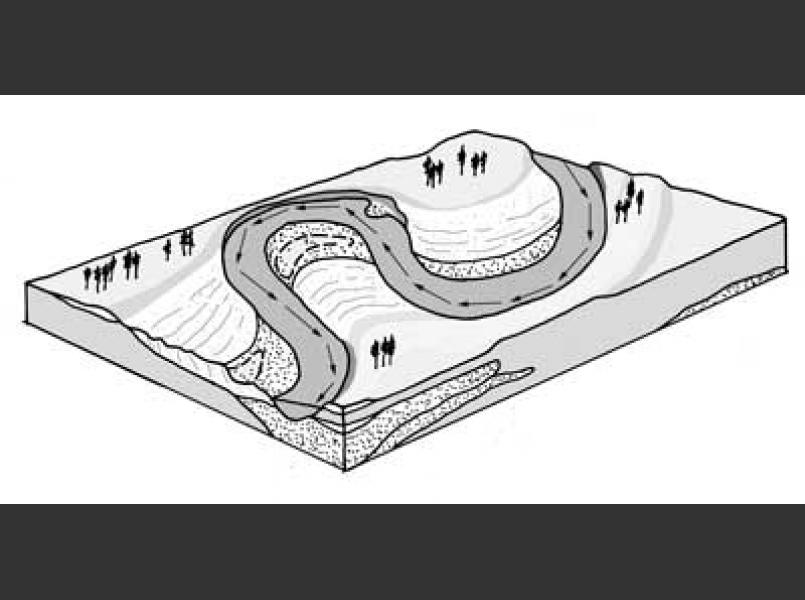 Unconfined, meandering channel
Unconfined, meandering channelConfined/unconfined channel – The Fish Friendly Farming Environmental Certification Program separates creek channels into two types according to their geologic features: confined and unconfined. Confined channels are in rocky canyons and gorges and are largely non-meandering and usually steep in slope. Unconfined channels are meandering channels typical of valley floors and are usually low in slope. Floods can scour and deposit sediment along the channel, changing its location and form.
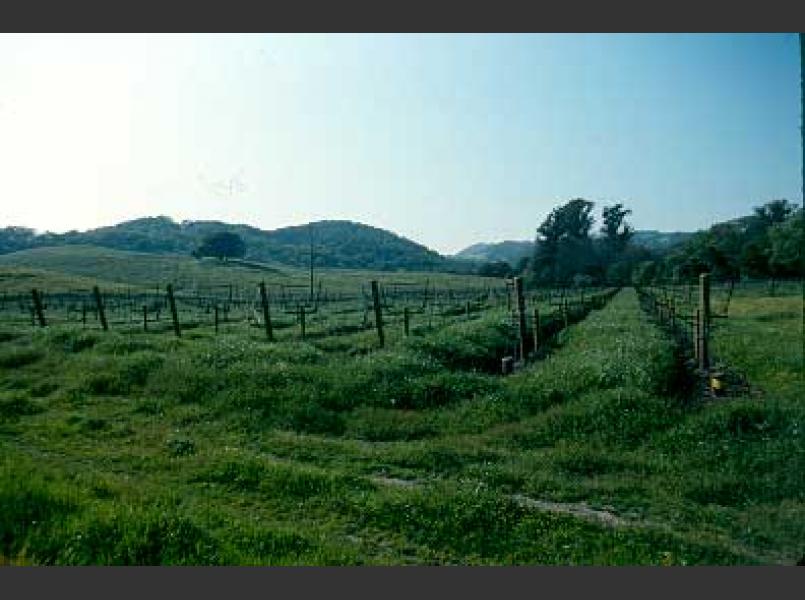 Cover Crop
Cover CropCover Crop– Cover crops consist of grasses, legumes, and forbs planted in the vineyard/orchard to protect soil from erosion and provide a variety of other benefits: nutrients, IPM, tilth, competition and to de-vigor vine growth. Cover crops may be annual, or perennial, mowed or disked during the growing season. Plant species can be selected for a variety of features and management schemes.
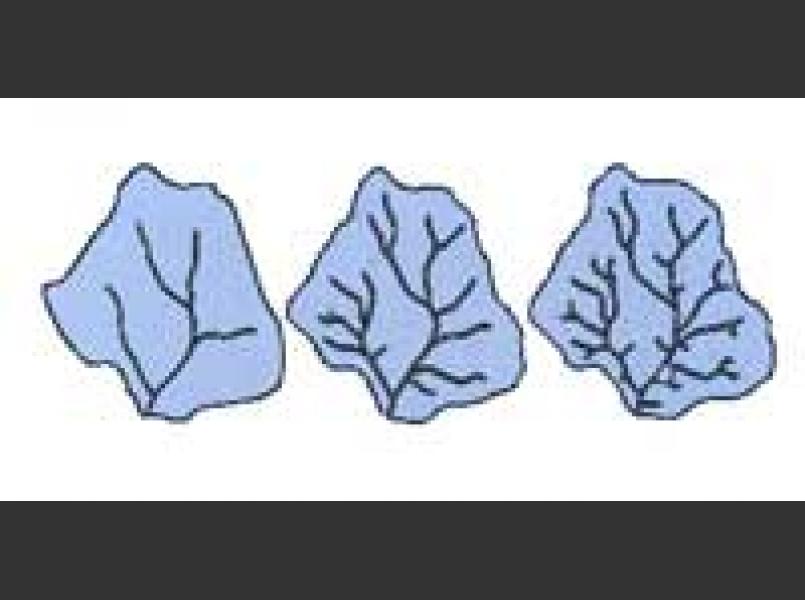 Drainage network
Drainage network Drainage network – The drainage network is the system of small to large stream channels that carry water from ridgetop to the river or ocean outlet of a watershed. The network includes small ephemeral creeks which only carry water during and after storms, seasonal or intermittent creeks, and year-round or perennial creeks and river channels.
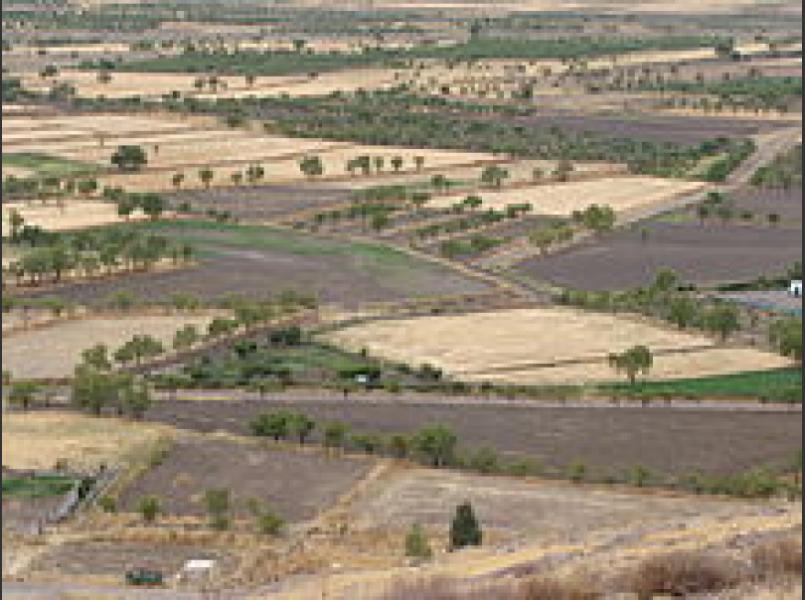 Dry farming
Dry farmingDry farming – Dry farming is the production of fruit, nuts, or other produce without irrigation. In vineyards, dry farming usually involves tilling of the avenues and vine rows to remove competing vegetation. Dry farming of grapes and fruit is done in many areas of the world.
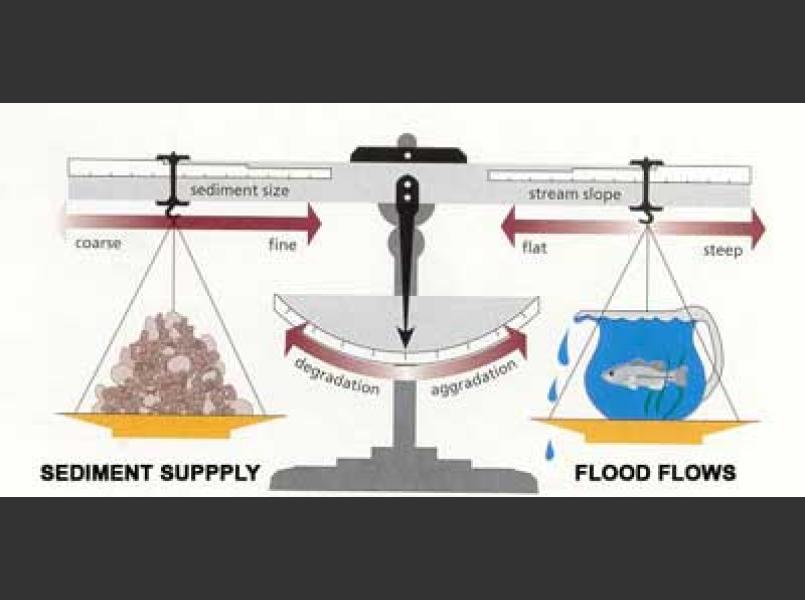 Dynamic equilibrium
Dynamic equilibriumDynamic equilibrium - Stream corridors exhibit a dynamic form of stability, known as dynamic equilibrium. Dynamic equilibrium refers to the ability of system to persist within a range of conditions. Maintaining this balance requires the presence of a series of self-correcting mechanisms or negative feedback loops. A disturbance to the stream ecosystem triggers a response from these self-correcting mechanisms allowing maintenance of the dynamic equilibrium.
Disturbances result from both naturally occurring and human-induced events. Climatic factors often play a role in naturally occurring disturbances and generally involve below- or above-normal precipitation and concomitant runoff. Human-induced disturbances often relate to changing land use patterns associated with development activities within the watershed.
While many stream ecosystems can tolerate fairly significant disturbances and maintain dynamic equilibrium, threshold levels exist. When thresholds are exceeded, the system becomes unstable. As the ecosystem adjusts over time, it moves towards a new dynamic equilibrium that may be different than the one that existed prior to the disturbance. In some instances, disturbances alter the system to such an extent that it cannot recover unless the cause of the disturbance is removed or actions are taken to restore stream functions.
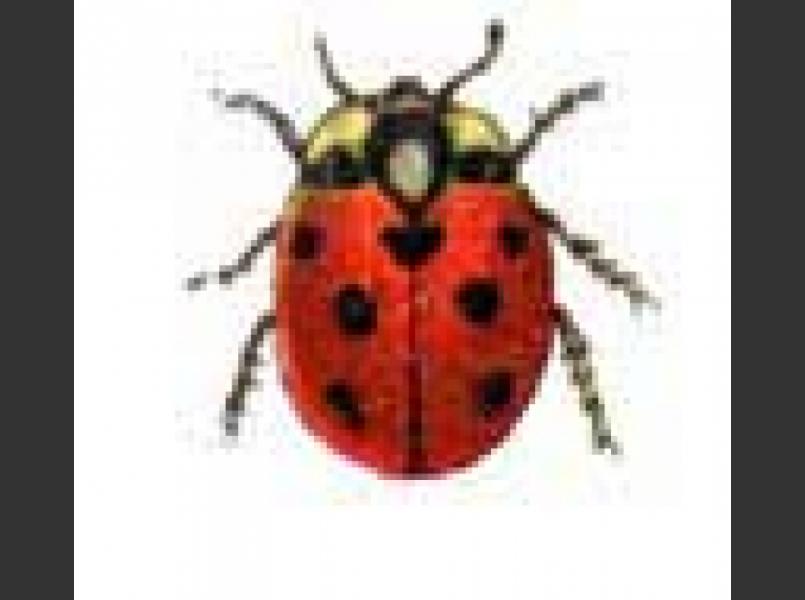 Integrated Pest Management (IPM)
Integrated Pest Management (IPM)Integrated Pest Management (IPM) – Integrated Pest Management (IPM) is an approach to pest management that encourages beneficial insects which prey on pest insects. To accomplish this, the grower must know the life cycles of pests and their interaction with the environment and predators. Plants that support beneficial insects need to be included in cover crops or areas adjacent to the vineyard/ orchard. In addition, some population of pest insects must be tolerated as a food source for beneficial insects; therefore, broad-spectrum pesticides cannot be used. Emphasis is placed on prevention and on targeted use of pesticides only if necessary. IPM requires that growers set economic thresholds to determine when action is necessary, and monitor and identify pests.
 No-till farming
No-till farmingNo-till farming – No-till farming involves very limited soil disturbance during the growing season over most of the agricultural field. In vineyards, no-till practices include mowing, not disking, vineyard avenues and controlling vegetation without ground disturbance.
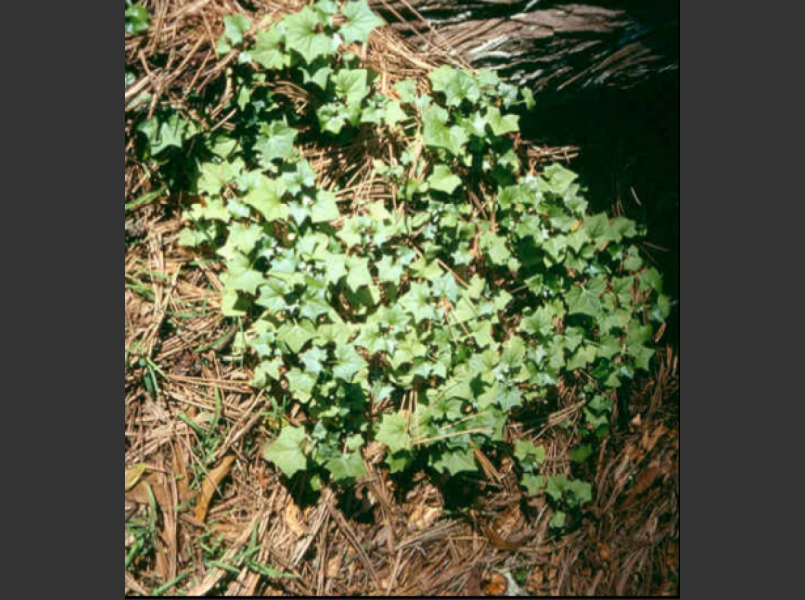 Non-native, invasive species
Non-native, invasive speciesNon-native, invasive species – Invasive species are plant or animal species that are not native to California but have been brought to the state as ornamental or agricultural species. Some non-native species escape into wildlands and invade native habitats, competing with natives and changing wildlife habitats. The non-native species that invade wildland and compete with natives are termed invasive species. There are many non-native species which are not invasive. Visit the California Invasive Plant Council (http://www.cal-ipc.org) to learn more.
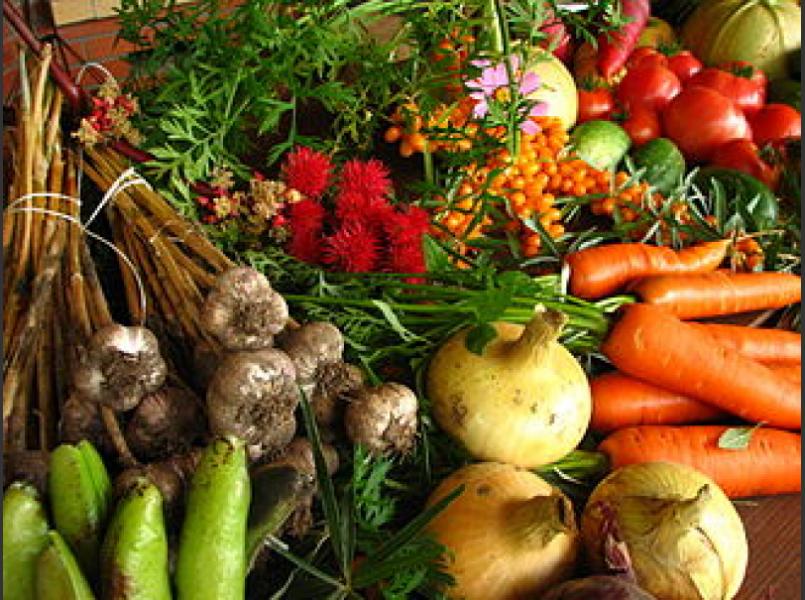 Organic farming
Organic farmingOrganic farming – Organic farming relies on crop rotation, compost, biological pest control, mechanical cultivation, and other practices to maintain soil productivity and control pests. Synthetic pesticides and fertilizers are strictly limited, but naturally occurring compounds such as pyrethrins, derived from flowers, can be used.
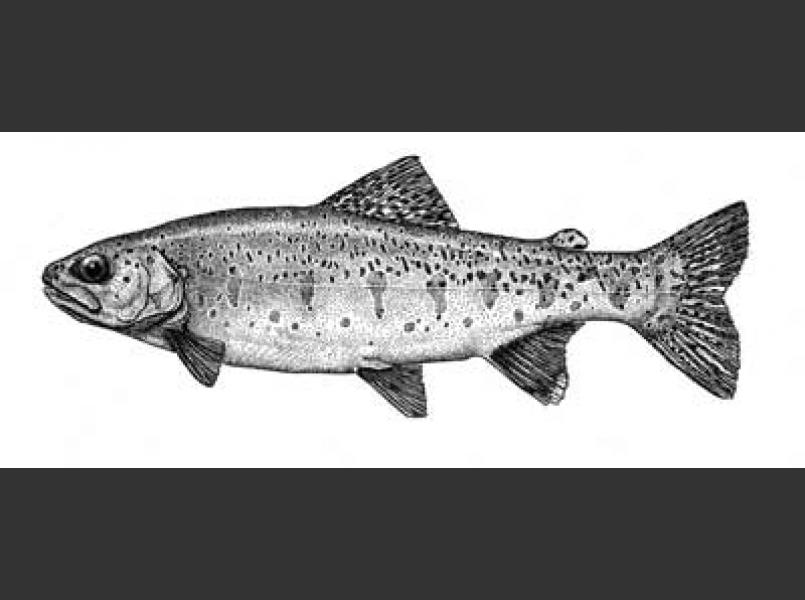 Riparian corridor
Riparian corridorRiparian corridor – Riparian corridors are the areas that grow along creeks and rivers where native plants grow on the floodplain. These areas are frequently flooded and have a combination of trees, vines, and herbaceous plants.
Riparian tree species are shown in this slideshow. Riparian plants slideshow (PDF)
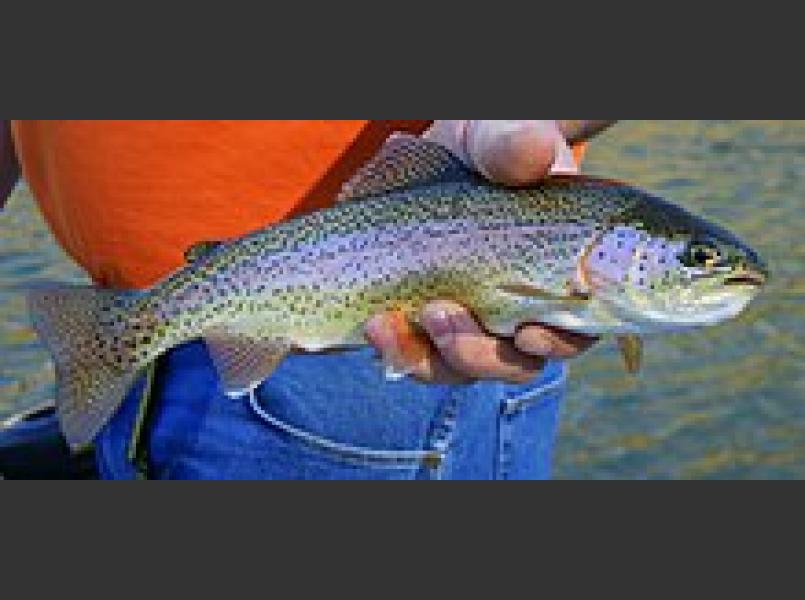 Steelhead trout
Steelhead trout Steelhead trout – Steelhead trout is an anadromous fish that ranges along the Pacific coast from Alaska to southern California. Steelhead hatch in fresh water streams and spend up to seven years in fresh water before migrating to the ocean to become mature adults. Steelhead also return to their natal streams to spawn, but unlike Pacific salmon, do not necessarily die after spawning and may live through several spawning cycles. Some of this species remain in fresh water their entire lives, either due to becoming landlocked through the construction of a reservoir or for some other reason; these trout are called “rainbow” trout although they are the same species as steelhead.
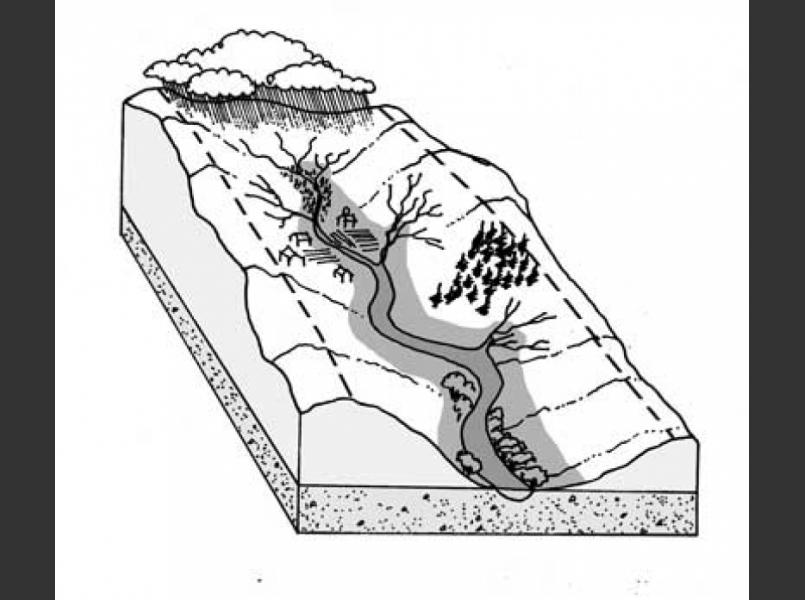 Watershed
WatershedWatershed - Watershed is the term used to describe the geographic area of land that drains water to an ocean or bay outlet. The watershed includes the geographic area surrounding the stream system that captures precipitation, filters and stores water, and generates runoff into the stream system. The stream system is the visible, aboveground portion of a larger drainage system. A watershed, therefore, is an area of land that drains water, sediment, and dissolved materials to a common outlet.
Any activity that changes soil permeability, vegetation type or cover, water quality, quantity, or rate of flow at a location can change the characteristics of a stream or even the watershed at downstream locations. Land use practices such as clearing land for timber or agriculture, developing and maintaining roads, housing developments, and water diversions may have environmental consequences that greatly affect stream conditions even when the land use is not directly associated with a stream. Proper planning and adequate care in implementing projects can help ensure that one activity within a watershed does not detrimentally impact the downstream environment.
In recent years, watersheds across the United States have become a focal point for community-based environmental conservation. Through the collaborative efforts of watershed groups – consisting of the people living and working within each watershed – major improvements in water quality, fisheries enhancement, wildlife habitat, and overall quality of life have been accomplished. A watershed provides water for drinking, recreation, and agriculture, and is a rich source of biological diversity that includes habitat for many threatened and endangered species, including salmon and trout.
